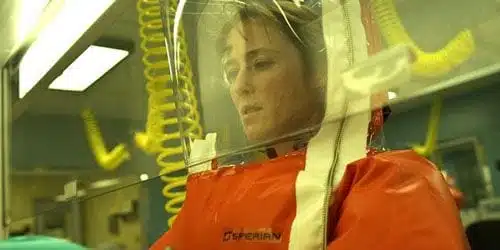
As soon as you hear Gwyneth Paltrow cough, you know where you’re headed. Contagion begins with sound on a black screen, a joke and also a warning. Cut to Paltrow as Beth, lovely as you expect, but her nose is red. She has her cell phone to her ear, an airport bar blurry in the background. She reaches for peanuts, she smiles, and she coughs again. I’m just jet-lagged,” she says. And she coughs again.
The camera cuts around, to the peanuts, to her credit card handed off to the waitress, to the touch-screen where the waitress lays her finger. Each surface is a menace. The contagion is spreading already, beginning here, in Hong Kong, where, a subtitle informs you, the population is 2.1 million. Beth’s fate is now sealed. She’ll return to her Minneapolis (3.3 million) home, where her very nice husband Mitch (Matt Damon) will fret as she continues to cough, as she sweats and collapses in the kitchen, and as she’s wheeled into a hospital emergency room, the curtain closed behind her.
Unable to see what happens next, Mitch is believably unbelieving when he learns, in a next scene, that Beth “didn’t make it.” The doctor (Stef Tovar) is perplexed and brusque, Mitch is stunned, especially when he hears in the next few moments that his stepson (Griffin Kane) — home sick from preschool after he hugged Beth a day before — is also turned for the worse. “Call 911,” Mitch instructs the babysitter, riding home in a cab when he gets that horrifying call. By the time he gets back, the child is dead, his eyes unseeing, his face gray, dried spittle on his lips.
Mitch does not die. For unknown reasons, he’s unaffected by the monstrous virus that invades the cell systems of his loved ones and, soon enough, millions of others. The disease quickly turns epidemic, even as officials from Homeland Security (one played by Enrico Colantoni) press for information from Ellis Cheever (Laurence Fishburne), a deputy director at the Centers for Disease Control and Prevention. Have terrorists weaponized the virus, they wonder. Cheever shows them graphs and numbers, his excellent technology colorful and alarming, The situation is dire, he notes, adding that because no one can grow the virus in a lab, no treatment or protocol is forthcoming. The doctors and the agents harrumph, the camera close up on their plainly concerned faces.
Such images are repeated as the film cuts from city to city and day to day. A World Health Oroganization doctor, Orantes (Marion Cotillard), seeks a starting point in Guangdong Province in China (100 million), as does Cheever’s emissary. Dr. Mears (Kate Winslet), who heads to Minneapolis, where she takes stock of who last touched a coffee cup Beth might have also touched. Orantes spends long minutes staring at video of Beth in a Hong Kong casino, trying to sort which direction a transmission might be going, from her breath on a set of dice or the gambler’s hands so near her mouth. Every encounter, every surface touched by someone who’s been coughing, becomes, in the film’s close-ups, a source of anxiety.
The virus spreads and so does the panic. A young man in Tokyo (36.6 million) sweats and dies on a bus, where a fellow passenger records him with a cellphone. The video attracts the attention of a blogger named Krumwiede (Jude Law), who knows immediately it’s a story worth pursuing, that the video will soon enough “be all over the planet.” When a newspaper editor (Monique Gabriela Curnen) blows him off (“it’s just one man in a video”), he complains mightily (“Print media is dying!”) and then uses his website — Truth Serum Now — to spread the word.
People fight over MREs and treatments that won’t work, they kidnap doctors and loot grocery stores and shoot each other. Hearing gunshots at his neighbor’s home one night, Mitch decides to keep his teenager Jory (Anna Jacoby-Heron) in the house. Cheever illicitly tells his wife (Sanaa Lathan) to leave Chicago for Atlanta: “Drive by yourself, stay away from other people.” You’ve seen these sorts of pieces in other disaster films, cautionary, broadly drawn. Here, some are silly and others just unimaginative, as when Cheever instructs a researcher (Elliot Gould) in San Francisco (3.5 million) to stop researching, at which point he does it anyway, impelled by one of those movie-style inspirations, and lo!, a discovery is made.
But Contagion is smart about the many opportunistic elements in play: fear and rage, cupidity and dishonesty, all shape different responses. FEMA and DHS and the CDC can’t manage all the movements. Even as Krumwiede guesses and condemns rapacious pharma’s next steps, he does his best to get ahead too, convincing his millions of unique viewers that he’s found a cure, one he means to invest in, by way of meetings on a park bench with a crepuscular speculator.
But even as social and moral orders collapse, the film keeps focused on carnal effects. When people are sick, they cough — again and again — and almost immediately collapse physically. Their eyes go fumy, their limbs flail. One autopsy scene shows the flap of skull skin peeled forward over the victim’s face, a grimly efficient evocation of how basic bodies are: flesh, bone, blood, all accessible with a circular saw.
Like Mitch, you are unable to see what happens next, what the doctors see. But they’re flabbergasted by what’s inside that skull, what you won’t see but can imagine (“Who should I call?” asks the assistant; “Call everyone!” comes the answer). What you do see, repeatedly, are bodies turning inside out, phlegmy, contorted, disintegrating. For all its melodramatic and paranoid thriller clichés, Contagion makes this idea mesmerizingly visible: connected even when they seem isolated, bodies fall apart.

